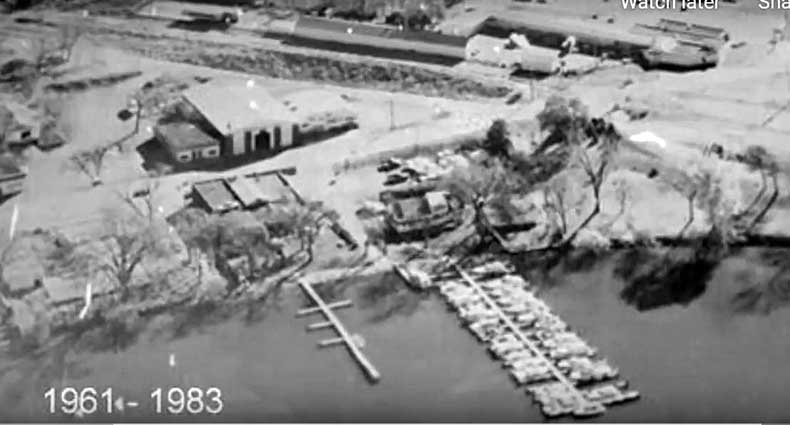Lakeview
Much of the information for this page comes from the October 2021 Newsletter of the Westonka Historical Society, written by Elizabeth Vandam.
THE HOLLOW
Only a short stretch long, the Hollow, as the locals still call it, was a section of Sunset Drive along the shore of West Arm on Lake Minnetonka in Spring Park. Incredibly, there were two hugely popular jazz venues on each side of this small stretch of road from about the 1940s to about 1970: The Downbeat was on the north side, and the Lakeview was on the south. Patrons came from all over the area (at the time a 25 minute drive from Downtown Minneapolis) to hear some of the biggest and best purveyors of jazz in the world. Some even came by boat!
THE LAKEVIEW INN
This page is about the Lakeview. There is a separate page about the Downbeat.
The name of the Lakeview underwent slight changes over the years. Never in any ad or article have I found a street address for this venue!
THE ATHLETIC CLUB
The building is obviously quite old, and an early use as a music venue was the Athletic Club Restaurant, owned by Carl and Ella Wicklund. The ad below shows that Bob Burak’s Orchestra provided music for dancing at the Athletic Club.
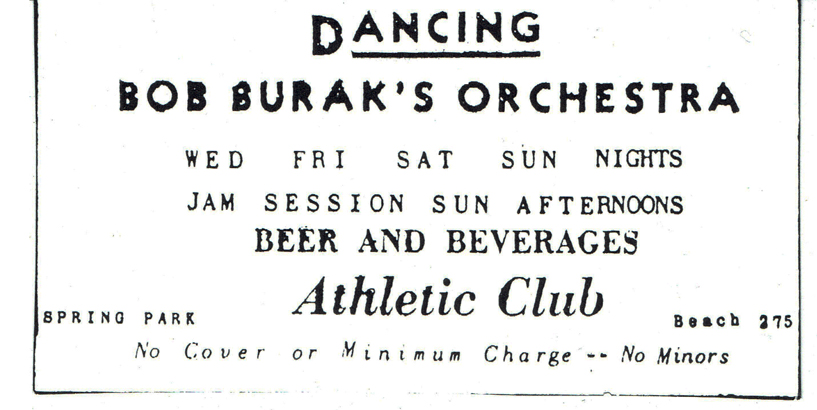
Ad courtesy Westonka Historical Society
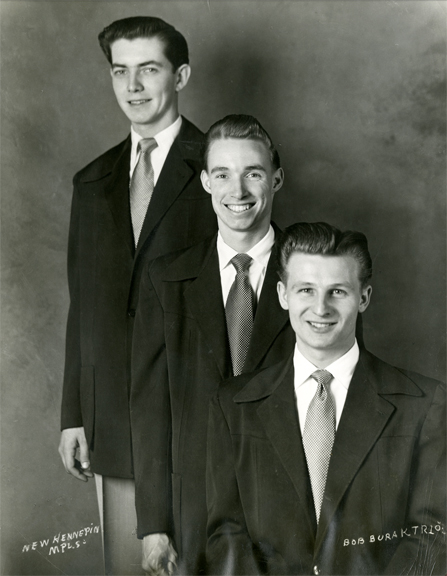
Bob Burak Trio. Photo from Burak Family Archives, courtesy Westonka Historical Society
At the time the photo below was taken (date unknown), the trio had four members: Bob on drums and saxophone, Wally Fuller on piano, Morrie Wasserman on trumpet, and Jerry Pearson on clarinet and saxophone. We can see the word “Club” on the sign outside, which means it’s probably still the Athletic Club.
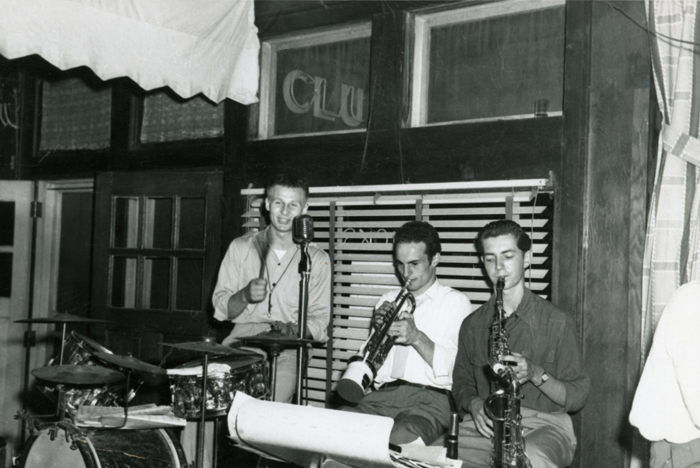
Bob Burak Trio. Photo from Burak Family Archives, courtesy Westonka Historical Society
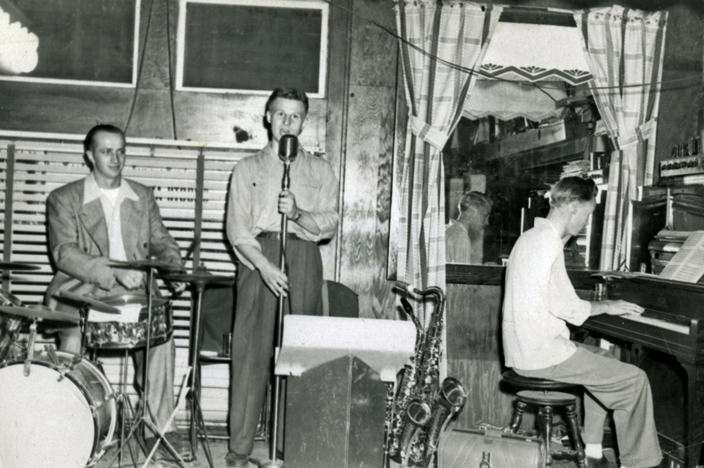
Bob Burak singing with his Trio. Photo courtesy Westonka Historical Society, Burak Family Archives.
BOB BURAK
The Lakeview Inn was born when the Wicklunds sold the Athletic Club Restaurant in 1949. The new owners were Bob and Eileen Burak. Bruno Milton (Bob) Burak was the son of a Polish dairy farmer who grew up in Willow River, Minnesota and moved to Minneapolis when he was 17. He trained to become a professional barber, and started playing music. After serving in World War II, he returned to Minnesota and worked as a musician and a barber to make ends meet. He dreamed of owning his own place to play music and offer good food.
Up in Crosby, Minnesota, Eileen Johnson was an 18-year-old telephone operator in 1947. Family lore is that Bob, then 23, was in the area one weekend to provide the musical entertainment at a dance. While attempting to place a call with Eileen’s assistance, the two chatted. Quietly, Eileen remained on the line after Bob thought that they had ended their conversation, and she found out where he would be playing that night. She made it to the show, and a year later they were married.
THE LAKEVIEW INN
The Lakeview Inn opened on May 7, 1949. Bob’s trio provided the entertainment. It may have taken time to catch on, as a 1951 ad refers to the reopening of the Athletic Club in Spring Park.
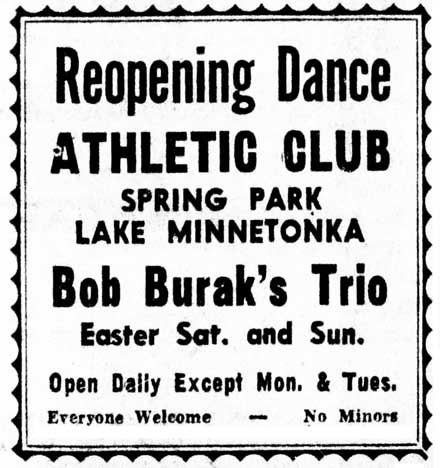
Minneapolis Star, March 23, 1951
LAKEVIEW DANCE INN
As is the usual case, the first evidence we find of the place is in the classified section, advertising for waitresses. Ten times, between June 3, 1955, and May 22, 1956, the club is referred to as the Lakeview Dance Inn.
LAKEVIEW INN
The first (and apparently only) ad in the Minneapolis papers made it clear that the name was actually the Lakeview Inn.
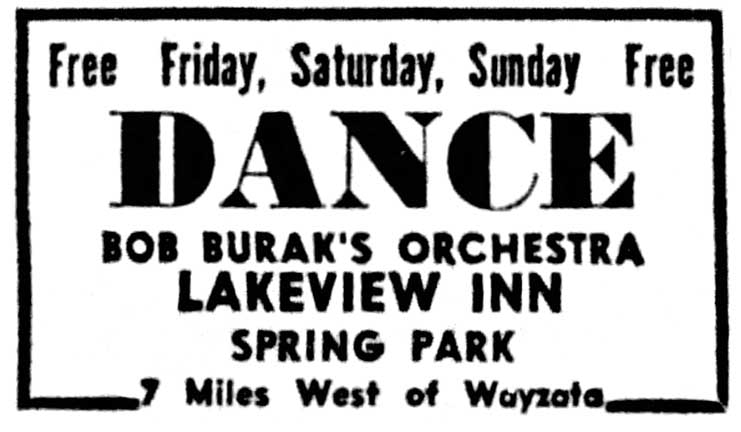
Minneapolis Star, June 4, 1955
DICK AND DON MAW
The Maw brothers moved to Minneapolis from Buffalo, New York, in 1944 when they were 10 and 12 years old. They formed a small combo and performed at various high school and college dances in the area while attending West High. One article said that Dick Maw was with the band for 20 years before moving to Lutsen in 1967, which would mean that they started their orchestra in 1947.
In May 1954 they founded the Twin Cities Jazz Society, which by August 1955 was reported to have several hundred members. In addition to performing in their own band, they became promoters; one of their first shows presented was a Louis Armstrong concert at the Lyceum Theater on November 21, 1954. On February 20, 1955, they brought Dave Brubeck to the Lyceum Theater as well.
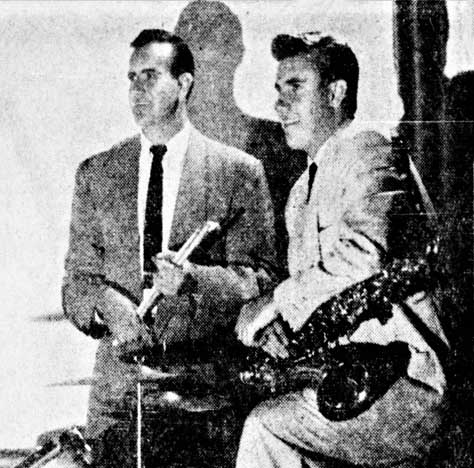
Dick and Don Maw. Photo from Minneapolis Tribune, August 21, 1955
By 1957 they were promoting jazz performers in Minneapolis and other cities, distributing a couple of dozen jazz labels, producing acts for Zephyr Records, and playing in and managing orchestras with 4 to 14 players. (Minneapolis Star, June 5, 1957)
1957
THE NEW LAKEVIEW
In 1957 the Lakeview Inn was renamed the New Lakeview, owned/leased by Dick and Don Maw, with help from their father, Ralph Maw.
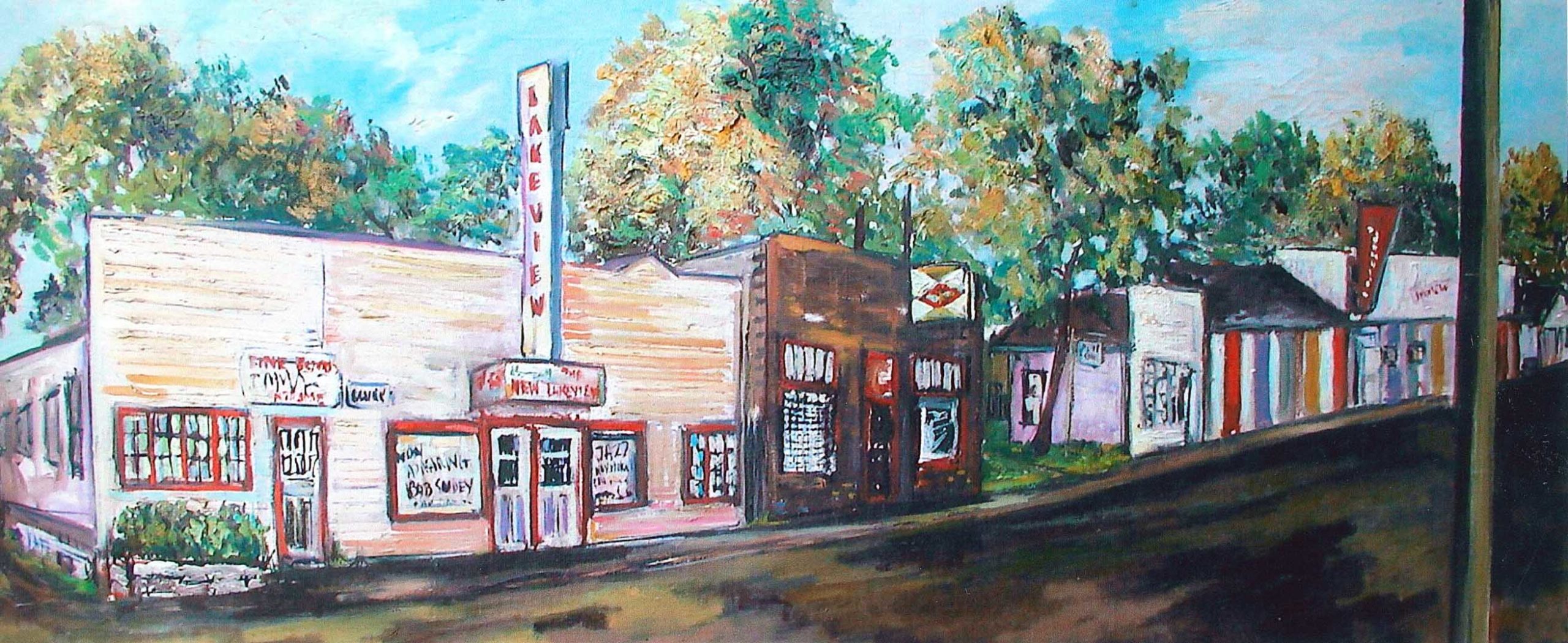
Painting of the New Lakeview by Dick Maw, courtesy of the Westonka Historical Society
It appears that at first, entertainment was provided by the Maw Brothers’ band.
On June 28, 1957, Will Jones reported:
Jazz is so successful on Lake Minnetonka that Dick and Don Maw say they will have their band in action five nights a week, instead of just three at their New Lakeview club at Spring Park [Wednesday through Sunday]. They also plan to ad water-ski shows at 2:30 pm Saturday and Sunday afternoons…
Unfortunately, the town council of Spring Park put the kibosh on the five-nights-a-week plan, refusing to grant them a dance license for Wednesday and Thursday nights. They did open on Thursdays with a listening-only trio. (Tribune, August 15, 1957)
Combined with the competing Downbeat Club, Spring Park was jumping on Summer nights in 1957, reported Will Jones. Cars, boats, even seaplanes jammed the little town. It took two policemen to handle traffic. (Tribune, July 2, 1957)
The first big-time band was book for October 15 through 27, extended through October 30, 1957. This was jazz trumpet artist Chet Baker.
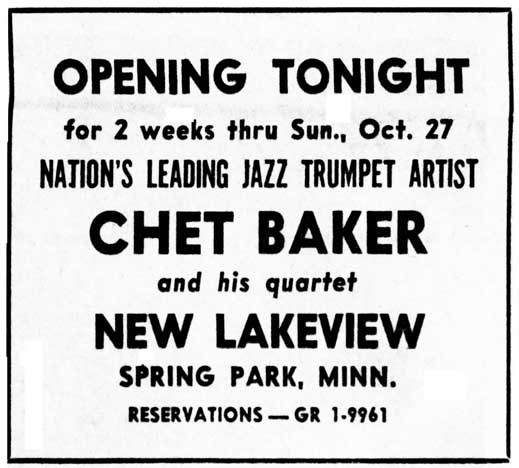
Minneapolis Star, October 15, 1957
On November 15 and 16, 1957, the club included a different kind of jazz when it welcomed Bob Scobey’s nine piece Dixieland band for the first time. The outfit include banjo player Clancy Hayes, two trombones, and a bass tuba.
(Please note that I will not be posting most other ads because they are not very interesting.)
Dixieland continued with the Harry Blons band in a series of Sunday night sessions starting at the end of November 1957, with guest soloists and Leigh Kamman as emcee. Name modern jazz groups were off the table until March – over the winter the entertainers would be the Dick Maw Trio, and something called “HiFi Jazz Sessions, with commentary, during intermissions.” Don’t know if that meant they were playing records or not.
1958
As promised, the club reopened on March 28, 1958, with the Phil Ruedy Trio, “Direct from Miami Beach.” Will Jones reported all the news in his column that day:
The place now boasts a glass roof over the dance floor (“dancing over the stars”), a new food policy (full dinner menu and chuck-wagon lunches), and a line-up of both modern and Dixieland jazz artist. Pianist Phil Ruedy heads a trio that will play six nights a week and Sunday afternoons through the summer. Local Dixieland groups continue their Sunday sessions. Bob Scobey’s San Francisco Dixieland band comes in next Tuesday for a three-night stay.
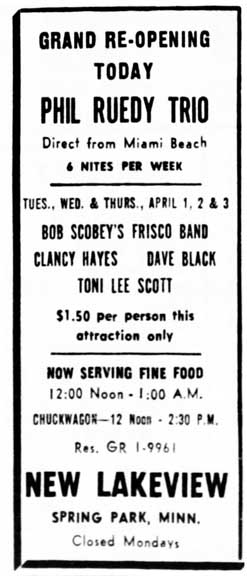
Minneapolis Star, March 28, 1958
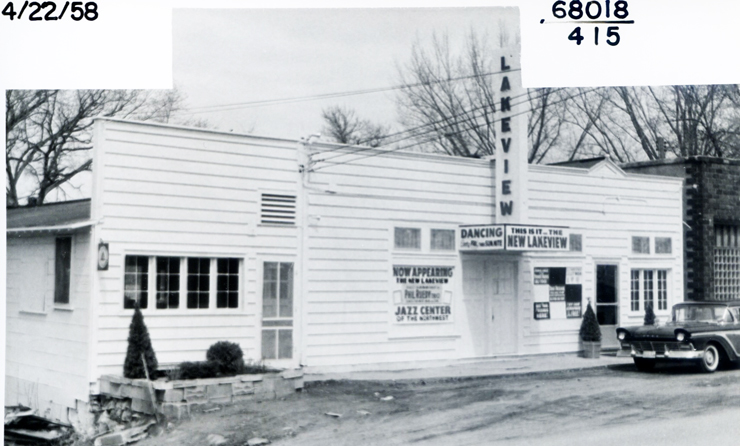
Photo from the Spring Park Assessor’s Office, courtesy Westonka Historical Society
Subsequent bookings in the spring of 1958 included:
The Herb Pilhofer Octet, for a session of modern jazz on April 27
Bob Scobey’s Frisco Band return engagement, May 3 and 4
John Doling Quartet, house band starting May 7
The Kai Winding septet, made up of four trombones and a rhythm section, on May 22. The group “grabbed for a fast booking between an engagement at the Blue Note in Chicago and a one-nighter in Superior, Wisconsin.” (Will Jones, May 22, 1958)
Chet Baker came in with a Chicago group for the Memorial Day weekend, stayed on through June 12.
Bob Scobey’s Dixieland band returned, June 13 through 15.
HERBIE MANN
Jazz Flutist Herbie Mann played a stand from July 1 through 20, 1958. He was backed by a local group made up of Marv Dahlgren, symphony tympanist, on vibes and drums; Skip Christman on piano; and Lynn Thompson on bass. Flutist Dave Kerr joined him on Sunday nights for some flute duets during his stay.
In an interview by Mercer Cross in the Minneapolis Tribune, Mann, 28, said that there was “definitely an audience for jazz in Minneapolis,” and “I’d rather play here than any other city in the country. The response has been wonderful, both personally and professionally.” He called our city “a virgin area as far as jazz goes. It’s off the beaten track that the jazz groups make. Either the money has to be good or there has to the another reason for coming here.” His reason was to vacation – he lived in New York with his wife Ruth, who worked as a secretary.
In the article his drummer was named as Tom D’Andrea. It also said that in addition to the flute, he also played tenor saxophone. He was given credit for the first, in 1953, to give the flute widespread popularity in modern jazz. He was in the process of forming and octet, and one of the reed men would be Dave Karr.
Kai Winding was back from July 20 through 27, 1958.
Pianist Oscar Peterson and his trio appeared on July 29 through August 2, 1958. His sidemen were Herb Ellis on guitar, Ray Brown on bass.
Dave Wesley’s Tomcats entertained from August 7 to 24, 1958. This outfit originated at St. Thomas College.
DAVE BRUBECK
The club’s new policy of big names only started with a bang, featuring jazz superstar Dave Brubeck smashing records in a 13-night stay starting on August 26, 1958. Paul Desmond appeared with him on alto sax, Gene Wright on bass, and Joe Morello on drums.
In a review by Mercer Cross, Brubeck was described as “a picture of animated concentration” as he opened with “St. Louis Blues.” Other pieces included “These Foolish Things” and “Watusi Drums,” the latter written by Brubeck.
The quartet played everything as if it had never been played before. That’s because they never play anything the same way twice. Brubeck, a jazz musician who takes his profession extremely seriously, explained it this way: “Playing jazz is something that is a night-to-night experience. When you can no longer communicate emotion, which is the duty of any artist, you might as well quit.” (Tribune, August 27, 1958)
Bob Murphy of the Tribune reported that Brubeck was packing them in.
Brubeck’s draw probably is due to the fact that he is one musician as entertaining visually as musically. Althletic and driving, his fingerwork is something to see, and in guts, imagination and technique he’s not to be topped. (August 31, 1958)
Cedric Adams weighed in as well:
I watched the jazz addicts of the Dave Brubeck quartet at a matinee over the weekend. These Brubeck fans go into a regular trance and are suddenly and regular brought into an explosion of applause during each solo number. If you want to give an order to a waitress while the quartet’s playing, you’d better do it in a soft whisper or you’ll get a loud “sssshhhhhh” from surrounding patrons….
The group has had standing room only since its opening at Lakeview last week. If you want to see fans completely entranced, drop out during this engagement. (Minneapolis Star, September 2, 1958)
Buddy Rich and his quintet opened on September 9 through 14, 1958.
The Chico Hamilton quintet opened September 19, 1958 for ten days.
Ernestine Anderson opened on October 5, 1958, for one week. Cedric Adams of the Star reported that her premiere was important enough to bring Jack Tracy, director of jazz for Mercury records, up for the opening. She had just recorded her first album, “Hot Cargo,” and been written about in Time magazine that August.
George Shearing appeared from October 13 through 19, 1958.
Bobby Hackett appeared from October 20 through 26, 1958. Hackett was a trumpet player.
COUNT BASIE
Count Basie was signed for October 27 and 28, doing two shows per night. Special prices went into effect for those shows: $5 per couple per show, or $10 for the evening.
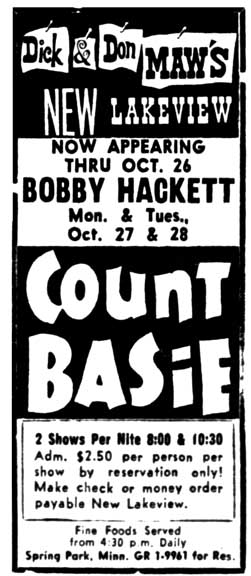
Minneapolis Star, October 20, 1958
DIZZY GILLESPIE
Dizzy Gillespie, “of the bop talk and the up-turned trumpet,” as Will Jones described him, opened for a week on November 24, 1958. The final Sunday he did a teenage matinee and evening show.
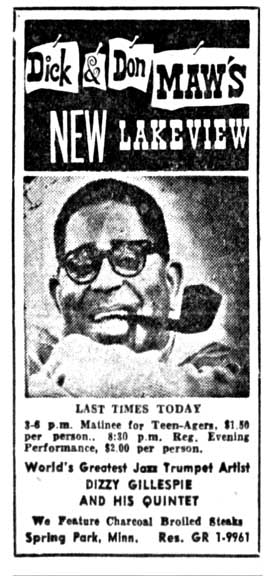
Minneapolis Tribune, November 30, 1958
Plans for the winter of 1958 called for the Herb Pilhofer trio on weekends. Jones also reported that the Maw Brothers were considering booking some name comedy performers to appear along with jazz groups during the winter. The papers were eerily silent.
1959
Two things happened in March 1959, and one wonders if one had to do with the other. First, Dick and Don Maw’s father, Ralph W. Maw, died on March 7, 1959, at the age of 56. In his obituary he was identified as the former owner of the New Lakeview Club. He was also described as the former Minneapolis film distributor for Metro Goldwyn Mayer. He had retired from MGM in 1957 and joined his sons in developing the New Lakewood.
The other thing that happened, and we don’t know timing, was that, as Will Jones reported on March 29, 1959,
Operators Dick and Don Maw have departed the place, and owner Bob Burak has repossessed it. He probably will go in for jazz on weekends this season, he said, but big names aren’t in the picture so far. He has booked the Colman Hechter jazz quartet for tonight.
What Jones may have meant by “repossessed” is anyone’s guess; either the Maws were buying the building and stopped making payments, or were renting and stopped paying rent. Either way, the New Lakeview as it was in its glory years, was gone.
LAKEVIEW INN
On May 8, 1959, the first classified ad appeared for a waitress for the reconstituted Lakeview Inn, again owned by Bob Burak.
On May 15, 1959, Will Jones reported that:
Dentley Haugesag, formerly with the Billy May and RayMcKinley orchestras, has organized a jazz group known as the Dent-Lee quartet. They will open Sunday night at the [still calling it the New Lakeview]. The Bob Sors Sextette is the Saturday night attraction at that spot. Beginning today, the Lakeview is reopening its kitchen.
That seems to be it for 1959.
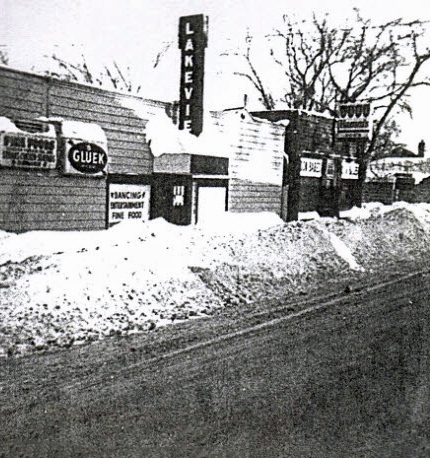
Undated photo of the Lakeville, courtesy Stan Straley
1960
A year later the classified ads in the spring promised that the waitresses would have fun, and entertainment at the night club was furnished by the Bob Burak Combo.
In August 1960 the Bob Scoby Dixieland band returned for a short stint. Will Jones reported,
Bob Burak is busy meanwhile with plans for the nights following Scobey’s departure. He plans to install Thursday talent night sessions and a piano bar, and to become active as a booker of talent. (Tribune, August 10, 1960)
1962 – 1962
There was only one classified ad in 1961, none in 1962.
1963
The club reopened in March 1963, featuring Burak’s combo on Saturdays, and Jimmy Wells, a Country artist, on Sundays.
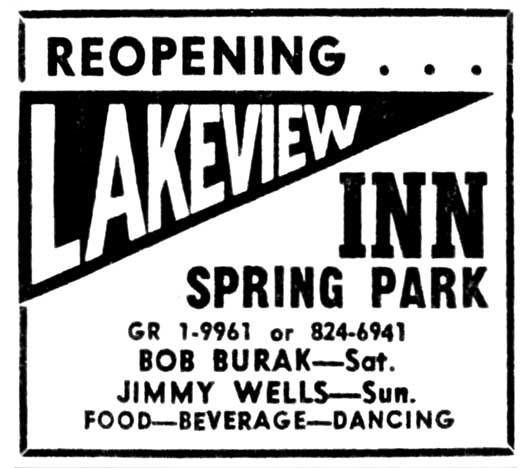
Minneapolis Star, March 21, 1963
This makes one wonder what kind of music Bob’s Combo was playing!
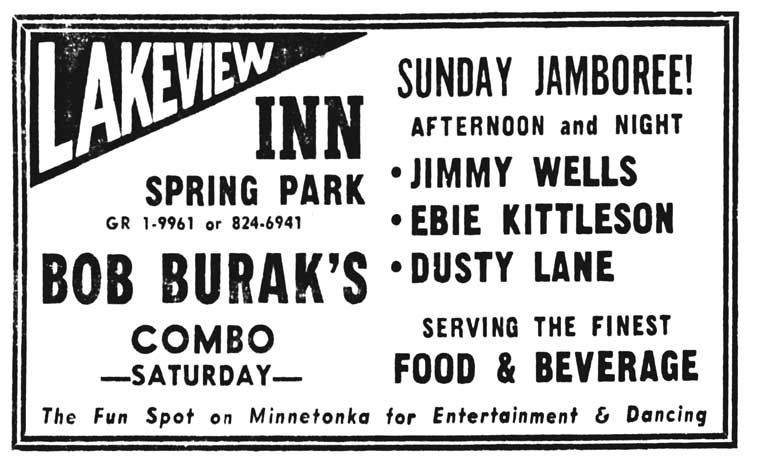
Minneapolis Star, March 28, 1963
The Dakota Roundup had been a fixture at the Flame Cafe on Nicollet Ave.
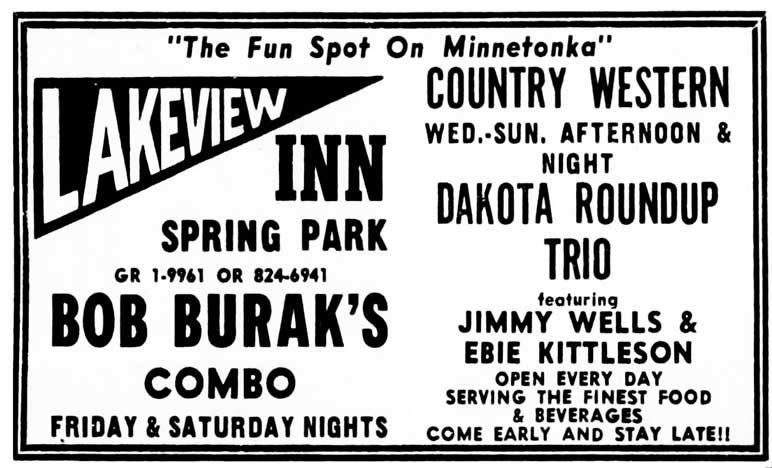
Minneapolis Star, April 1, 1963
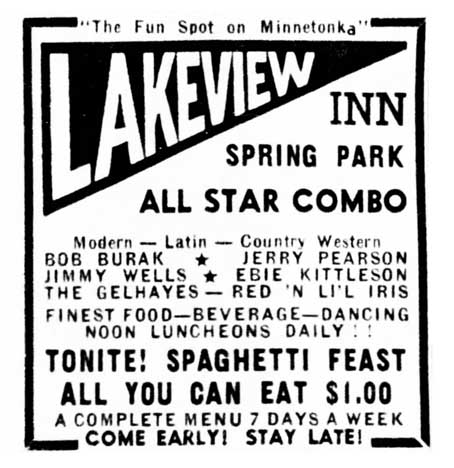
Minneapolis Tribune, June 26, 1963
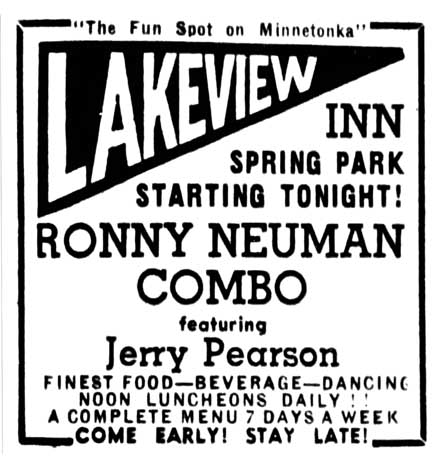
Minneapolis Tribune, July 5, 1963
And then…. nothing.
1964
There are no hits for the Lakeview or for Burak in 1964.
1965
The Minneapolis papers don’t tell the tale, but apparently the Lakeview Inn was hoppin’ in the summer of ’65. Things must have gotten out of control – in August 1965, Bob printed a plea in the classifieds for a manager/partner, listing the assets of the “Nite Club” and ominously offering to sell them off separately. That last part was omitted in later ads, which ran from August 5 to August 15, 1965.
Here’s Will Jones, writing about that crazy summer in his column on November 16, 1965:
Out at Spring Park, where the Lakeview had the rock scene going so frantically all summer they used to lock the doors at 11:00 of a Saturday night, things have slowed down a little. But Bob Burak swears he’s not going to let them come to a dead halt. He’s open three nights a week, Friday through Sunday, and the house band is there Friday and Saturday nights.
This ad also shows up in November 1965. Apparently Bobby Burak was Bob’s 14-year-old son.
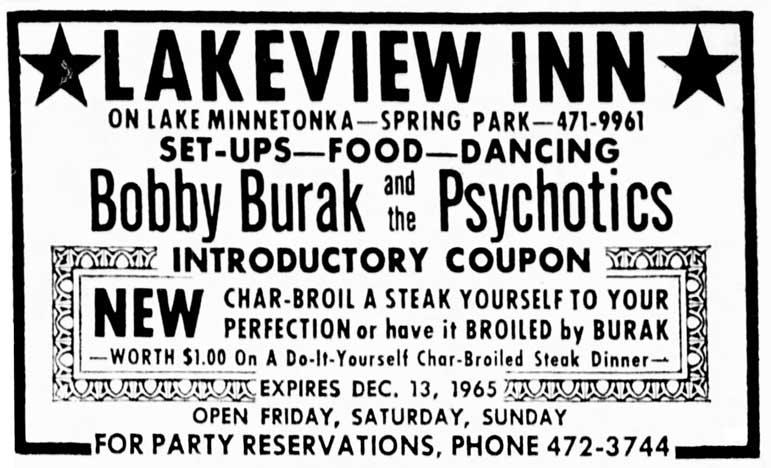
Minneapolis Star, November 25, 1965
The Lakeview became a year round venue that welcomed teens as a safe hangout with a juke box, food and soft drinks, pool, and foosball. Many local teens were employed at the Lakeview as well.
Paul E. Taylor posted the wonderful photo below on Facebook! You can see the Lakeview, then a dive bar called Don & Babe’s. Hidden by trees is the old Spring Park City Hall, and then the Downbeat.
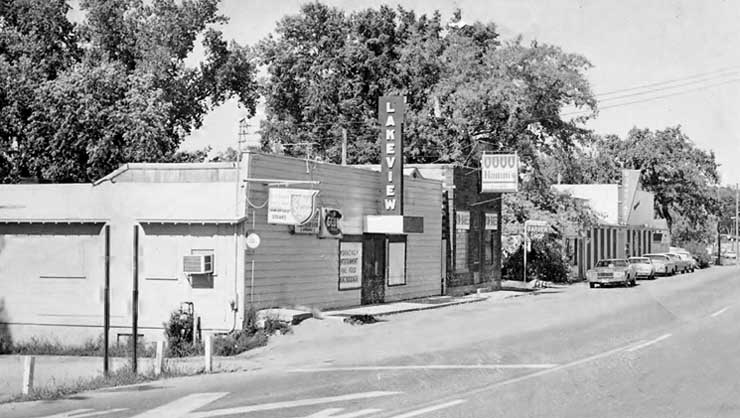
The Lakeview – photo courtesy Paul E. Taylor
By August 1966 Bob was advertising for a manager/partner again.
Will Jones wrote about Spring Park in his column in the Tribune on June 13, 1967. Most of it was about the Downbeat, but he did mention that the Lakeview featured a small rock band and attracted a younger clientele. And then he went into his usual girlwatching spiel that wouldn’t pass muster today…
A December 1967 in the Minnetonka Herald showed the same weekend schedule and Bob Burak’s new Combo.
But in April 1969, Bob Burak was again trying to sell all of his holdings on the lake.
In 1970 and 1973, ads were placed trying to find musicians to play at the club.
And below is the last ad I found for the Lakeview Inn.
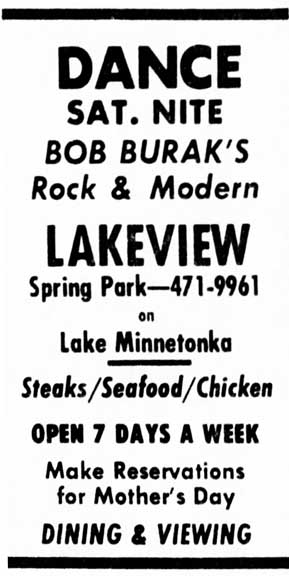
Minneapolis Tribune, May 12, 1973
The last classified ad for a waitress was placed on June 20, 1973, and the place still belonged to Burak.
In 1968 Bob Burak started selling real estate in the Lake Minnetonka area, with consistent ads until July 4, 1979. He died in 1990 at the age of 66.
The Lakeview is gone now, as is the Hollow – now a part of Rockvam’s Boat Yard, a marina which had been establishing itself since the earlier years of the music scene.
